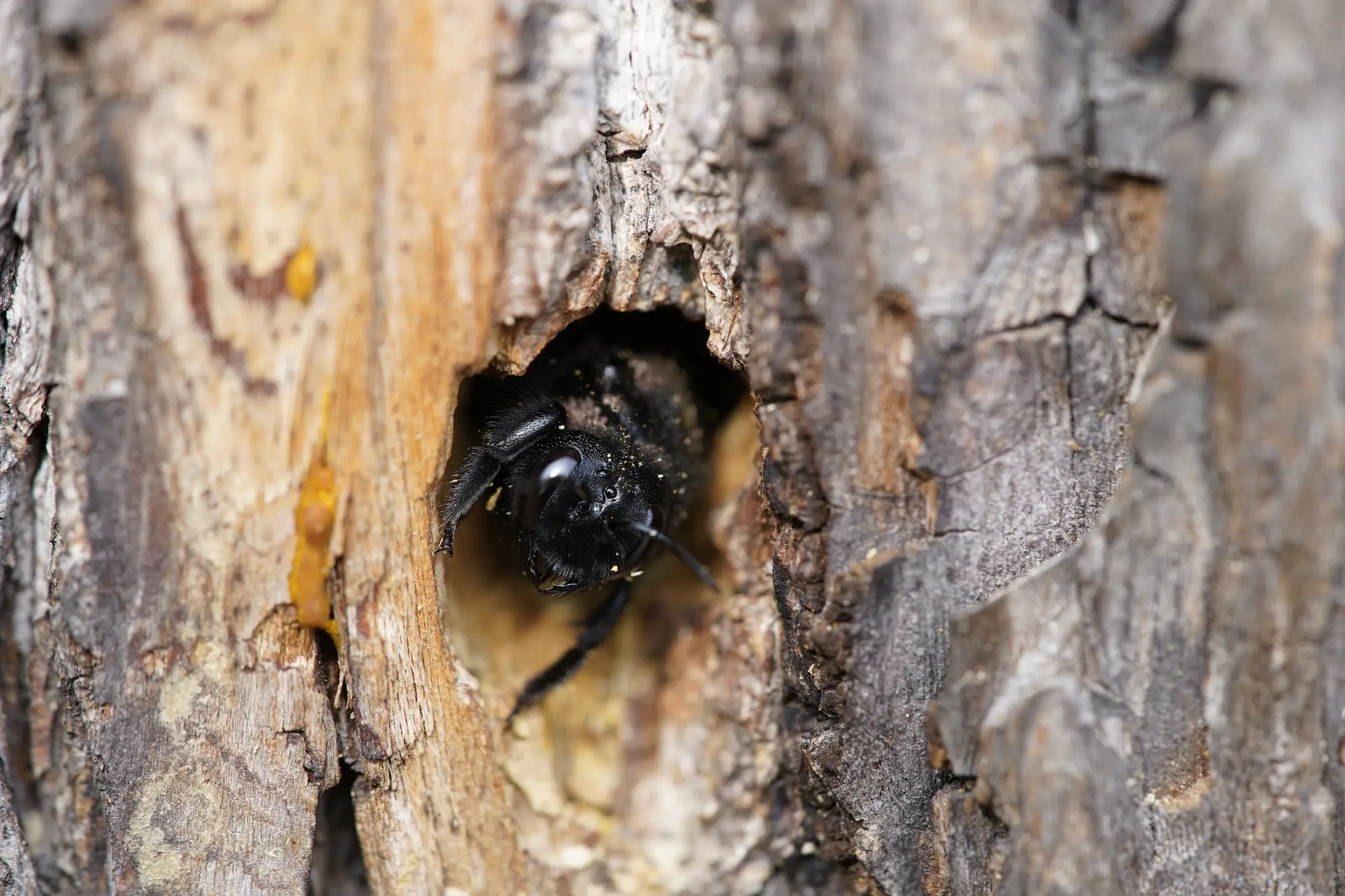
In Suffolk County & Nassau County, large bees lingering near wooden structures like decks and porches are likely carpenter bees. These solitary insects become active in spring and early summer, drilling small, round holes to lay their eggs. Their actions may appear harmless at first, but problems can grow rapidly without intervention. Regular inspections can catch damage before it spreads. Male carpenter bees can’t sting, and females rarely do, yet the harm they cause is anything but harmless.
Suburban Exterminating specializes in effective carpenter bee management. Our trained professionals locate problem areas, eliminate active bees, and shield your property from lasting damage.
Are Carpenter Bees a Serious Threat to Your Home?
Repeated drilling from carpenter bees can gradually compromise your home’s wooden structures. What starts as minor wear can grow into costly repairs. This type of damage may cause:
- Distinct Entry Holes: Carpenter bee holes are smooth, round, and about the size of a nickel. They’re often spotted in exposed areas like rafters, eaves, or beneath decks where bees start drilling to build their nests.
- Visible Wood Damage: The presence of carpenter bees often shows through shallow trenches, dots, or small dashes on the surface of wood. Unlike termites, they leave their work exposed, making their activity easy to identify.
- Compromised Support Beams: When carpenter bees bore into load-bearing beams, they can gradually weaken the wood’s core. If left untreated, this may lead to warping, sagging, or even partial structural failure over time.
- Damaged Steps: Bees tunneling into wooden steps slowly hollow them from within, reducing stability and strength. This type of hidden damage can cause steps to crack or collapse, posing a safety hazard similar to weakened railings.
- Weakened Railings: Porch and balcony railings are frequent carpenter bee targets, and repeated tunneling can make them unsafe. Over time, the wood’s strength deteriorates, increasing the likelihood of collapse or injury if repairs are delayed.
Carpenter bees can cause more damage than you might expect, so reach out to a professional stinging insect exterminator at the first sign of trouble. Our team uses advanced solutions to eliminate pests and keep them from returning. We’re here whenever you need us.
Need Carpenter Bee Control?
How to Identify Carpenter Bees
Carpenter bees resemble bumblebees in size and shape, with round, fuzzy bodies and dark heads. However, their shiny, hairless abdomens set them apart from their fully hairy counterparts. Many homeowners mistake one for the other until they notice the bees drilling into wood.
They target untreated or weathered wood such as that found on decks, fences, and sheds. Their nesting process starts with a small, round hole, followed by tunnels that stretch deep into the grain. Over time, these burrows can weaken wood from within, often before you notice surface signs.
Unlike bumblebees or wasps that build external nests, carpenter bees live entirely within wooden structures. This behavior can lead to ongoing damage if infestations recur year after year.
Common Signs of Carpenter Bee Activity
It’s important for homeowners to recognize the signs of carpenter bee activity. Small holes and visible markings in wooden structures are clear indicators. Early detection can save you from expensive repairs. Common signs include:
- Internal Sounds: Faint scratching or buzzing coming from inside wooden structures, indicating that carpenter bees are actively nesting.
- Wood Shavings: Piles of sawdust or tiny wood pieces often collect on the ground or nearby surfaces directly under the entry holes.
- Fan-Shaped Marks: Semi-circular or fan-like patterns surrounding the entrance holes, clearly showing where carpenter bees have started tunneling.
- Visible Holes: Small, round openings about half an inch in diameter that appear in untreated wood, marking the start of bee tunnels.
Carpenter Bees: From Small Holes to Serious Issues
Carpenter bees can cause more than cosmetic harm to your wooden structures. Inside their tunnels, developing larvae create faint scratching and buzzing sounds. While these noises are easy to miss, wildlife quickly picks up on them, putting your property at additional risk. Taking steps early can save both time and money.
Birds such as woodpeckers are drawn to the larvae as a food source. Their pecking enlarges the entry holes, turning minor damage into more severe structural issues. Acting swiftly prevents both the bees and the secondary harm from predators.
Suburban Exterminating Protects Your Home from Unwanted Bees
The best defense against carpenter bees and the wildlife they attract is professional treatment. In Suffolk County & Nassau County, these pests can be a recurring problem, and ignoring them may escalate the damage. Prompt action ensures your home’s integrity stays intact and reduces long-term repair costs. At Suburban Exterminating, our experts detect infestations, deliver targeted solutions, and secure your property against ongoing risks.
Contact Suburban Exterminating today to discover how our professional treatments keep carpenter bees and other pests at bay.
Back to Bee, Wasp, & Hornet Exterminators – Control – Removal